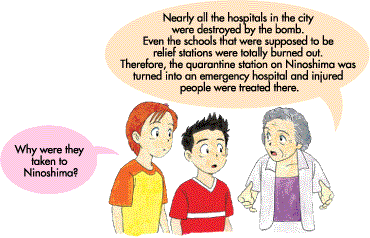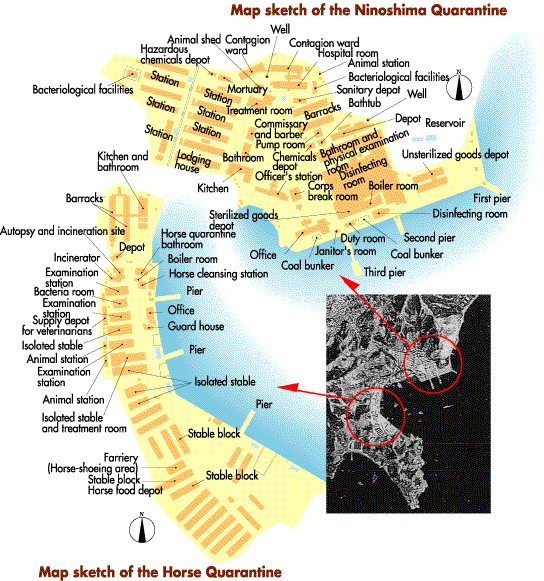 |
| Relief Activities Immediately after the Bombing |
| The atomic bombing destroyed Hiroshima. City Hall and the Prefectural Offices ceased all functions. Transportation and communication were paralyzed. The first unit to the rescue was the Army Marine Headquarters commonly known as the Akatsuki Corps. They were stationed in Ujina, and therefore sustained only light damage. The Akatsuki Corps entered the city immediately after the bombing, boating up the rivers to fight fires and rescue the injured. They transported victims by the boatload first to Ujina, then on to Ninoshima or Kanawajima islands. The quarantine station had enough medical supplies and blankets for 5,000 people, and the bomb did little damage to buildings. It was only natural that Ninoshima became an emergency relief station. |
 |
11 Ninoshima, bodies piled on the pier at Ujina Drawing / Masaaki Shimizu August 7, 1945 Approx. 4,700 m from the hypocenter, Ujina-machi After being taken to Ujina, the injured were taken on to Ninoshima or Kanawajima islands. Many died along the way. Ujina pier, seen here from the middle, was soon piled high with the bodies of those who ran out of strength. |
 |
 |
| 12 Carrying injured in a truck Drawing / Kazuo Matsumuro August 6, 1945, about 5:00 p.m. Approx. 1,700 m from the hypocenter, near Hijiyama Bridge Roads in the city had become mountains of rubble, and fierce flames made it difficult for any vehicle to get through. Of those who managed to escape to a refuge away from the fires, the most seriously injured were placed into a truck and carried to Ujina. |
|
| 14 Map sketch of the Ninoshima Quarantine 15 Map sketch of the Horse Quarantine |
13 Two aerial photo of the quarantine station Photo / US Army August 7, 1945 This photo of the quarantine station vicinity is an enlargement of the aerial photograph taken from an altitude of approx. 9,000 meters by the U.S. military. This photo shows building, piers, and ships heading for piers of those days. |
 |
|
|
Island of Final Rest
Ninoshima and the Atomic Bombing Military City Hiroshima and the Ninoshima Quarantine Station Atomic Bombing Relief Activities Immediately after the Bombing Ninoshima Overflowing with Injured Anguished Voices Calling for Water; Family Members Searching for Loved Ones Sending off the Dead The Closing of the Emergency Field Hospital, then the Quarantine Station A-bomb Orphans Ninoshima of the Sleeping Dead Conclusion Return to TOP |